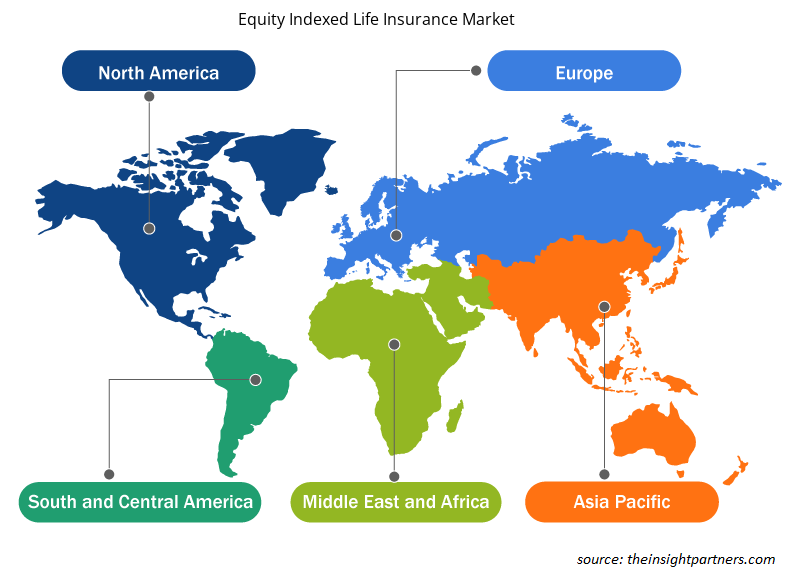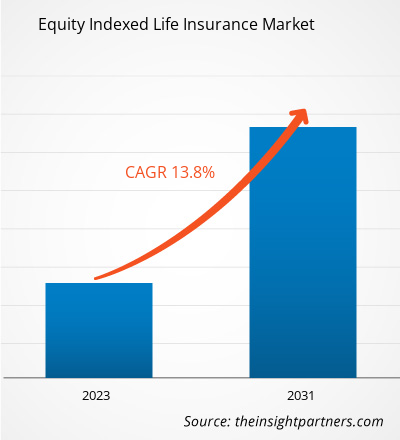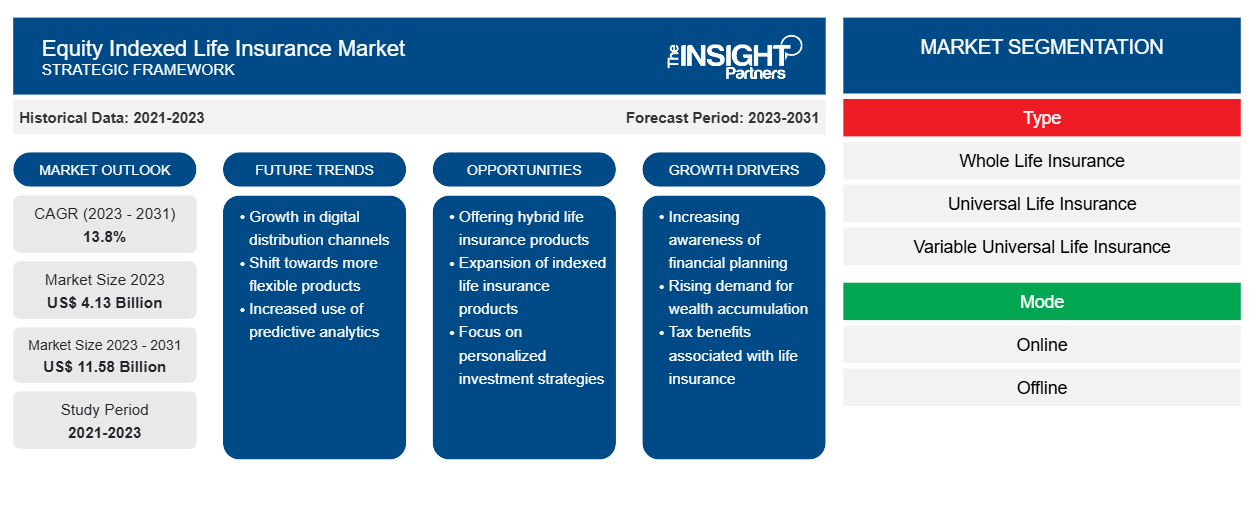Der Markt für aktienindexierte Lebensversicherungen soll von 4,13 Milliarden US-Dollar im Jahr 2023 auf 11,58 Milliarden US-Dollar im Jahr 2031 wachsen; von 2023 bis 2031 wird eine durchschnittliche jährliche Wachstumsrate von 13,8 % erwartet. Der Markt für aktienindexierte Lebensversicherungen bietet Wachstumsaussichten aufgrund der aktuellen Trends auf dem Markt für aktienindexierte Lebensversicherungen und ihrer vorhersehbaren Auswirkungen während des Prognosezeitraums. Der Markt für aktienindexierte Lebensversicherungen ist ein großer und wachsender Sektor. Der Markt für aktienindexierte Lebensversicherungen wächst aufgrund des zunehmenden Wirtschaftswachstums, des steigenden Bewusstseins und der Aufklärung der Verbraucher sowie der verbesserten Zugänglichkeit von Versicherungen.
Aktienindexierte Lebensversicherungsmarktanalyse
Aktienindexierte Lebensversicherungen sind eine Art Lebensversicherung, die Merkmale sowohl traditioneller Lebensversicherungen als auch von Anlageprodukten kombiniert. Bei aktienindexierten Lebensversicherungen wird ein Teil der Prämienzahlungen für die Bereitstellung einer Todesfallleistung an die Begünstigten verwendet, ähnlich wie bei einer normalen Lebensversicherung. Ein anderer Teil der Prämie wird jedoch in indexierte Konten investiert, die an die Entwicklung des Aktienmarkts gekoppelt sind. Der Markt für aktienindexierte Lebensversicherungen wird von Faktoren wie der wirtschaftlichen Lage, regulatorischen Änderungen und der Verbrauchernachfrage nach Versicherungs- und Anlageprodukten bestimmt.
Branchenübersicht zum Markt für aktienindexierte Lebensversicherungen
- Die aktienindexierte Lebensversicherungsbranche ist ein Sektor innerhalb des breiteren Versicherungsmarktes, der eine Kombination aus Lebensversicherungsschutz und Investitionsmöglichkeiten bietet.
- Diese Policen bieten den Versicherungsnehmern im Vergleich zu herkömmlichen Lebensversicherungen die Möglichkeit höherer Renditen, da sie an den Kursgewinnen der Börse teilhaben können. Allerdings sind sie auch mit einem garantierten Mindestzinssatz ausgestattet, der die Investition vor Marktrückgängen schützt.
- Die Branche richtet sich an Personen, die eine Lebensversicherung abschließen und gleichzeitig ihre Ersparnisse durch Investitionen vermehren möchten.
Passen Sie diesen Bericht Ihren Anforderungen an
Sie erhalten kostenlos individuelle Anpassungen an jedem Bericht, einschließlich Teilen dieses Berichts oder einer Analyse auf Länderebene, eines Excel-Datenpakets sowie tolle Angebote und Rabatte für Start-ups und Universitäten.
-
Holen Sie sich die wichtigsten Markttrends aus diesem Bericht.Dieses KOSTENLOSE Beispiel umfasst eine Datenanalyse von Markttrends bis hin zu Schätzungen und Prognosen.
Treiber des aktienindexierten Lebensversicherungsmarktes
Verbesserte Versicherungsverfügbarkeit soll den Markt für aktienindexierte Lebensversicherungen ankurbeln
- Eine verbesserte Zugänglichkeit von Versicherungsprodukten kann dem Markt für aktienindexierte Lebensversicherungen erheblichen Auftrieb verleihen. Durch einen leichteren Abschluss von Versicherungen können mehr Menschen an Anlagemöglichkeiten teilnehmen.
- Durch die verbesserte Zugänglichkeit können mehr Menschen von den potenziellen Erträgen und dem Schutz profitieren, die aktienindexierte Lebensversicherungen bieten.
- Ein größerer Kundenstamm motiviert die Versicherungsunternehmen zu mehr Innovation und einem aggressiveren Wettbewerb. Dies führt zur Entwicklung neuer Produkte, verbesserter Dienstleistungen und potenziell niedrigeren Kosten für die Verbraucher.
- Daher wird der zunehmende Zugang zu Versicherungen, einschließlich aktienindexierter Lebensversicherungen, das Marktwachstum vorantreiben.
Segmentierungsanalyse des Marktberichts für aktienindexierte Lebensversicherungen
- Basierend auf dem Modus ist der Markt für aktienindexierte Lebensversicherungen in Online und Offline segmentiert. Es wird erwartet, dass das Online-Segment im Jahr 2023 einen beträchtlichen Marktanteil bei aktienindexierten Lebensversicherungen halten wird.
- Es wird erwartet, dass das Online-Segment im Prognosezeitraum auch die höchste durchschnittliche jährliche Wachstumsrate (CAGR) aufweist.
Aktienindexierte Lebensversicherung – Marktanteilsanalyse nach geografischer Lage
Der Markt für aktienindexierte Lebensversicherungen ist im Wesentlichen in fünf Regionen unterteilt: Nordamerika, Europa, Asien-Pazifik, Naher Osten und Afrika sowie Südamerika. Nordamerika erlebt ein schnelles Wachstum und wird voraussichtlich einen bedeutenden Marktanteil bei aktienindexierten Lebensversicherungen halten. Der Markt für aktienindexierte Lebensversicherungen in Nordamerika verzeichnet ein stetiges Wachstum. Diese Policen bieten eine Kombination aus Lebensversicherungsschutz und dem Potenzial für eine Barwertakkumulation, die an die Entwicklung eines Aktienmarktindex gekoppelt ist. Veränderte Marktbedingungen könnten jedoch das Marktwachstum in Nordamerika beeinflussen.
Regionale Einblicke in den aktienindexierten Lebensversicherungsmarkt
Die regionalen Trends und Faktoren, die den Markt für aktienindexierte Lebensversicherungen im Prognosezeitraum beeinflussen, wurden von den Analysten von Insight Partners ausführlich erläutert. In diesem Abschnitt werden auch die Marktsegmente und die Geografie für aktienindexierte Lebensversicherungen in Nordamerika, Europa, im asiatisch-pazifischen Raum, im Nahen Osten und Afrika sowie in Süd- und Mittelamerika erörtert.

- Erhalten Sie regionale Daten zum aktienindexierten Lebensversicherungsmarkt
Umfang des Marktberichts zum aktienindexierten Lebensversicherungsmarkt
| Berichtsattribut | Details |
|---|---|
| Marktgröße im Jahr 2023 | 4,13 Milliarden US-Dollar |
| Marktgröße bis 2031 | 11,58 Milliarden US-Dollar |
| Globale CAGR (2023 - 2031) | 13,8 % |
| Historische Daten | 2021-2023 |
| Prognosezeitraum | 2023–2031 |
| Abgedeckte Segmente |
Nach Typ
|
| Abgedeckte Regionen und Länder |
Nordamerika
|
| Marktführer und wichtige Unternehmensprofile |
|
Dichte der Akteure auf dem Markt für aktienindexierte Lebensversicherungen: Die Auswirkungen auf die Geschäftsdynamik verstehen
Der Markt für aktienindexierte Lebensversicherungen wächst rasant. Dies wird durch die steigende Nachfrage der Endnutzer aufgrund von Faktoren wie sich entwickelnden Verbraucherpräferenzen, technologischen Fortschritten und einem größeren Bewusstsein für die Vorteile des Produkts vorangetrieben. Mit der steigenden Nachfrage erweitern Unternehmen ihr Angebot, entwickeln Innovationen, um die Bedürfnisse der Verbraucher zu erfüllen, und nutzen neue Trends, was das Marktwachstum weiter ankurbelt.
Die Marktteilnehmerdichte bezieht sich auf die Verteilung der Firmen oder Unternehmen, die in einem bestimmten Markt oder einer bestimmten Branche tätig sind. Sie gibt an, wie viele Wettbewerber (Marktteilnehmer) in einem bestimmten Marktraum im Verhältnis zu seiner Größe oder seinem gesamten Marktwert präsent sind.
Die wichtigsten Unternehmen auf dem Markt für aktienindexierte Lebensversicherungen sind:
- Prudential Financial, Inc
- Penn Mutual
- American International Group, Inc
- Equitable Holdings, Inc
- MetLife Services und Solutions, LLC
Haftungsausschluss : Die oben aufgeführten Unternehmen sind nicht in einer bestimmten Reihenfolge aufgeführt.

- Überblick über die wichtigsten Akteure auf dem Markt für aktienindexierte Lebensversicherungen
Die „Aktienindexierte Lebensversicherungsmarktanalyse“wurde basierend auf Typ, Modus, Vertriebskanal und Geografie durchgeführt. Basierend auf dem Typ ist der Markt in Lebensversicherungen, Universal-Lebensversicherungen, variable Universal-Lebensversicherungen, indexierte Universal-Lebensversicherungen und andere unterteilt. Basierend auf dem Modus ist der Markt in Online und Offline unterteilt. Basierend auf den Vertriebskanälen ist der Markt in Versicherungsgesellschaften, Agenturen und Makler sowie Banken unterteilt. Basierend auf der Geografie ist der Markt in Nordamerika, Europa, Asien-Pazifik, den Nahen Osten und Afrika sowie Südamerika unterteilt.
Nachrichten und aktuelle Entwicklungen zum Markt für aktienindexierte Lebensversicherungen
Unternehmen verfolgen auf dem Markt für aktienindexierte Lebensversicherungen anorganische und organische Strategien wie Fusionen und Übernahmen. Nachfolgend sind einige aktuelle Marktentwicklungen aufgeführt:
- Im Januar 2024 führten Ameritas und Ethos eine neue Index-Universal-Lebensversicherung ein, die den Kunden die Geschwindigkeit und Bequemlichkeit eines webbasierten Prozesses sowie die Anleitung eines Agenten bietet. Die neue Index-Universal-Lebensversicherung wird ausschließlich über Ethos angeboten.
[Quelle: Ameritas, Firmenwebsite]
- Im Februar 2024 kündigten der private Lebensversicherer Bajaj Allianz Life und das Nichtbanken-Finanzunternehmen – Mikrofinanzinstitut (NBFC-MFI) Satin Creditcare Network Limited eine strategische Partnerschaft mit dem Versicherungsmakler Coverfox an, um den Zugang zu Lebensversicherungen in ländlichen Gebieten zu verbessern. Durch diese strategische Partnerschaft können Kunden von Satin Creditcare ihre Kredite mit den Versicherungsplänen von Bajaj Allianz Life absichern.
[Quelle: Bajaj Allianz Life, Unternehmenswebsite]
Bericht zum Markt für aktienindexierte Lebensversicherungen – Abdeckung und Ergebnisse
Die Marktprognose für aktienindexierte Lebensversicherungen wird auf der Grundlage verschiedener sekundärer und primärer Forschungsergebnisse geschätzt, wie z. B. wichtiger Unternehmenspublikationen, Verbandsdaten und Datenbanken. Der Marktbericht „Marktgröße und Prognose für aktienindexierte Lebensversicherungen (2021–2031)“ bietet eine detaillierte Analyse des Marktes, die die folgenden Bereiche abdeckt:
- Marktgröße und -prognose auf globaler, regionaler und Länderebene für alle abgedeckten wichtigen Marktsegmente.
- Marktdynamik wie Treiber, Beschränkungen und wichtige Chancen.
- Wichtige Zukunftstrends.
- Detaillierte PEST- und SWOT-Analyse
- Globale und regionale Marktanalyse, die wichtige Markttrends, wichtige Akteure, Vorschriften und aktuelle Marktentwicklungen abdeckt.
- Branchenlandschaft und Wettbewerbsanalyse, einschließlich Marktkonzentration, Heatmap-Analyse, Schlüsselakteuren und aktuellen Entwicklungen.
- Detaillierte Firmenprofile.
- Historische Analyse (2 Jahre), Basisjahr, Prognose (7 Jahre) mit CAGR
- PEST- und SWOT-Analyse
- Marktgröße Wert/Volumen – Global, Regional, Land
- Branchen- und Wettbewerbslandschaft
- Excel-Datensatz
Aktuelle Berichte
Verwandte Berichte
Erfahrungsberichte
Grund zum Kauf
- Fundierte Entscheidungsfindung
- Marktdynamik verstehen
- Wettbewerbsanalyse
- Kundeneinblicke
- Marktprognosen
- Risikominimierung
- Strategische Planung
- Investitionsbegründung
- Identifizierung neuer Märkte
- Verbesserung von Marketingstrategien
- Steigerung der Betriebseffizienz
- Anpassung an regulatorische Trends























 Kostenlose Probe anfordern für - Aktienindexierter Lebensversicherungsmarkt
Kostenlose Probe anfordern für - Aktienindexierter Lebensversicherungsmarkt